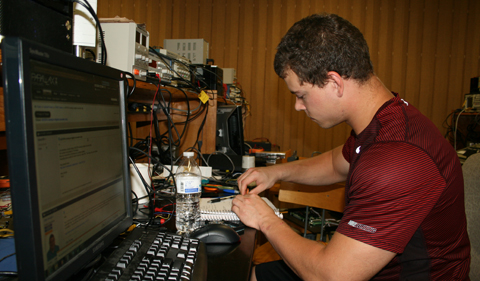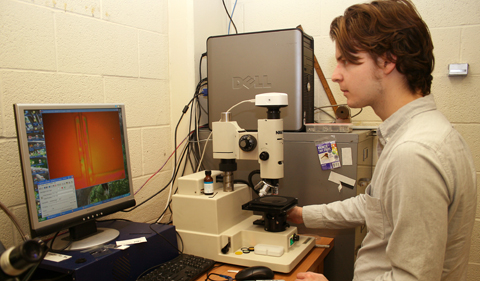
Justin Courtright
By Justin Courtright
(Physics and Applied Mathematics, Class of 2016)
My research with Dr. Eric Stinaff in Physics & Astronomy investigated how to produce an Atomic Force Microscope (AFM) with an Arduino microcontroller and quartz tuning fork. Ideally, the AFM should be able to resolve objects down to 1 nanometer (one billionth of a meter).
Before I started this internship, I had never heard of an AFM before, and the thought of building one seemed like a daunting challenge. Luckily, there are several published papers on the subject that helped me understand the physics, mathematics, and circuitry involved in building the AFM.
By driving the tuning fork at its precise resonant frequency using a function generator attached to the Arduino, I maximize the amount of current going through the tuning fork. By converting this current to voltage, amplifying the signal, and using a peak-detector to create a DC output, I create a system where the output drops off nearly completely if the tuning fork is disturbed.
The sensitivity of the tuning fork allows it to sense forces from objects on the micrometer to nanometer scale. By combining the sensing system with a motorized stage controlled by another Arduino, I can scan surfaces and create images of the surface.
Working on this project makes me excited for the future of open-source electronics and the Maker community. Using three Arduinos, a direct digital synthesizer, a computer speaker, a watch tuning fork, and some resistors and op-amps, it is possible to make precise scientific equipment that can be used in real experiments and costs far less than buying one pre-made.
Overall, I learned a lot about AC electronics and piezo-electric materials. I also improved my coding skills that I developed the previous summer working for Dr. Stinaff.
Justin Courtright – 2015 Intern with Dr. Eric Stinaff – senior at Ohio University – College of Arts & Sciences –physics and applied mathematics major



















Comments